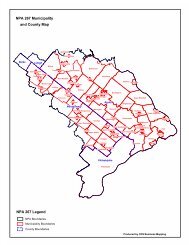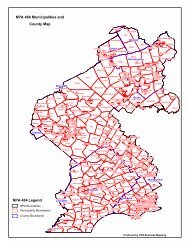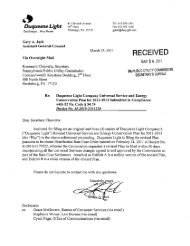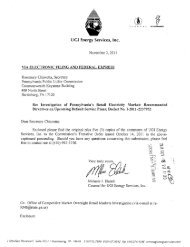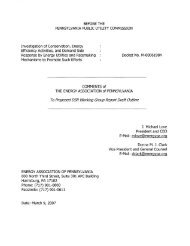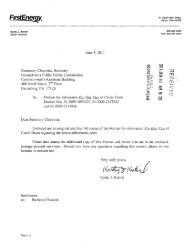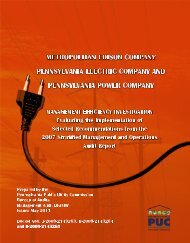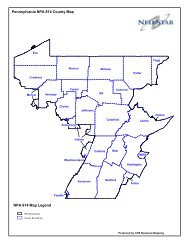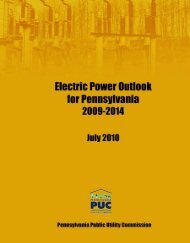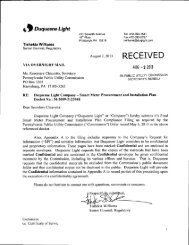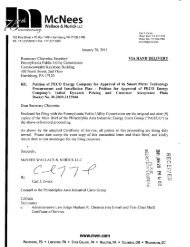Spring/Summer Edition of Keystone Connection - Pennsylvania ...
Spring/Summer Edition of Keystone Connection - Pennsylvania ...
Spring/Summer Edition of Keystone Connection - Pennsylvania ...
Create successful ePaper yourself
Turn your PDF publications into a flip-book with our unique Google optimized e-Paper software.
<strong>Keystone</strong> <strong>Connection</strong> - TelecommunicationsPUC Implementingthe New Chapter 30Over the past few months, the PUC hastaken numerous steps to implement thevarious provisions <strong>of</strong> the new Chapter 30,which was signed into law as Act 183 byGov. Ed Rendell on Nov. 30, 2004, and tookeffect the next day. The original Chapter 30was in place from July 1993 until it expiredon Dec. 31, 2003.Under the original Chapter 30, the PUCwas authorized to permit a reduced, alternativeform <strong>of</strong> regulation for incumbent localexchange carriers (ILECs) who promised100 percent broadband deployment by 2015.Act 183 seeks to encourage earlier completion<strong>of</strong> these commitments by providingILECs with the ability to file amended networkmodernization plans (NMPs) toaccelerate broadband deployment. In return,the new legislation <strong>of</strong>fers ILECs more economicincentives and lesser PUC regulation,particularly in the area <strong>of</strong> reporting requirements.Currently, the PUC is processing amendedNMPs filed by all 33 <strong>Pennsylvania</strong> ILECs,which must be ruled upon within 100 days <strong>of</strong>the filing date. The first amended NMP wasapproved on March 3, and it is expected thatall remaining ones will be acted upon by theend <strong>of</strong> June.On March 8, the PUC entered a tentativeorder seeking comments regarding Lifelineprograms and eligibility notifications. As toreporting requirements, on March 23 thePUC voted at Docket No. M-0004185 to eliminatevarious pre-Act 183 reports and convenedfacilitated discussions on May 11 toaddress the content <strong>of</strong> the annual financialreport, as well as the validity <strong>of</strong> other reportsthat remain open for comment. By order enteredon March 29 (Docket No. L-00050170),the PUC initiated a proposed rulemaking toeliminate the requirement for interexchangecarriers to file tariffs for intrastate competitiveservices. On June 23, the PUC is expectedto impose the first annual assessments foreducation technology funds. Other measurestaken by the PUC include efforts to definethe NMP audit process and the review <strong>of</strong>filings made by ILECs containing competitiveservice designations.Amended Chapter 30Network Modernization PlanProvisions Act 183 allows ILECs to amend their original Chapter 30Network Modernization Plan (NMP) to accelerate broadbanddeployment in return for additional regulatory relief.The new law outlines three broadband acceleration options forILECs. Option 1, chosen by all but two rural ILECs, commits thecompany to 100 percent broadband availability in its serviceterritory by Dec. 31, 2008. Option 2, chosen by Sprint/UnitedTelephone and ALLTEL, requires 100 percent broadband availabilityby either Dec. 31, 2013, or Dec. 31, 2015, as does Option 3 whichonly applies to Verizon PA and Verizon North. Options 2 and 3mandate the <strong>of</strong>fering <strong>of</strong> a Bona Fide Retail Request Program(BFRR) and a Business Attraction and Retention Program (BARP).Under all three options, the ILECs committed to 100 percentbroadband availability for public schools, industrial parks, andhealth care facilities by Dec. 31, 2005; technical assistance topolitical subdivisions; a 30 percent discount for intrastatebroadband services to schools via a three-year contract; andtechnical assistance to schools applying for E-Rate funding.For ILECs serving less than 50,000 access lines, Act 183provides a waiver <strong>of</strong> non-facilities-based interconnection rules underSection 251(c) <strong>of</strong> the federal Telecom Act until Dec. 31, 2008.Therefore, competitive local exchange carriers must use their ownnetwork to compete with small ILECs.In March, the first amended NMP was approved and all theremaining ones are expected to be acted upon by the end <strong>of</strong> June.Assistance Programs AvailableThe telephone assistance programs, Link-Up and Lifeline 150,are undergoing significant changes because <strong>of</strong> Act 183 and theFederal Communications Commission’s (FCC) April 29, 2004,Lifeline and Link-Up Order. Link-Up provides eligible householdswith discounts on their line connection charges while Lifeline 150provides a monthly credit for one telephone line.Act 183 contains new Lifeline rules for eligible telecommunicationcarriers (ETCs), and the Department <strong>of</strong> Welfare (DPW), suchas the “automatic notification” <strong>of</strong> DPW program recipients <strong>of</strong> theeligibility for Lifeline service and the elimination <strong>of</strong> restrictions onvertical services for Lifeline 150 customers.By order entered on May 23, the Commission entered a finalorder at Docket No. M-00051871, implementing changes to thecurrent eligibility requirements for these programs because <strong>of</strong> theFCC’s new Lifeline and Link-Up order eligibility requirements. Thefinal order expands the program to include the FCC’s income onlycriterion (135 percent <strong>of</strong> the federal poverty guidelines) and addsthe National School Lunch free lunch program as a qualifyingprogram. Also, in accordance with the provisions <strong>of</strong> Act 183, non-ETCs are no longer required to provide Lifeline service. Interestedparties were invited to provide comments regarding these changes.6 <strong>Keystone</strong> <strong>Connection</strong>
<strong>Keystone</strong> <strong>Connection</strong> - TelecommunicationsTriennial Review RemandOrder UpdateIn March, following a long and complex history, newfederal rules became effective that govern access to anincumbent local exchange carrier’s (ILEC’s) unbundlednetwork elements (UNEs). In its Triennial Review RemandOrder, the Federal Communications Commission (FCC)phases out the UNE-Platform over 12 months to eliminatedisincentives to infrastructure investment. The FCC alsoclarifies the impairment standard and modifies itsapplication <strong>of</strong> the unbundling framework.If parties cannot reach agreement on alternative termsfor discontinued UNEs, a transition plan is provided toservice the embedded base <strong>of</strong> customers. The new ruleswill be implemented by the parties through amendedinterconnection agreements pursuant to change <strong>of</strong> lawprovisions.Unbundling FrameworkThe touchstone <strong>of</strong> “impairment” (access to UNEs) hasbeen a vague uneconomic entry standard. Theimpairment standard is now based on the capabilities <strong>of</strong> a“reasonably efficient competitor,” defined as “a hypotheticalcompetitor acting reasonably efficiently.” Thisstandard is the underlying support for the new rules, and itis being challenged on appeal. Other modifications <strong>of</strong> theframework are: use <strong>of</strong> UNEs exclusively for mobile wirelessor long-distance services (“competitive downstreammarkets”) is prohibited; the prospect for competition in ageographic market is now based on the state <strong>of</strong>competition in other, similar markets; and UNEs can beused to replace ILEC special access in the localexchange market for several reasons including thepossibility <strong>of</strong> ILECs engaging in price squeeze behavior.Dedicated Inter<strong>of</strong>fice TransportThe impairment test for dedicated transport is based onbusiness line counts and fiber-based collocators in ILECwire centers. Competing carriers (CLECs) may accessDS1 transport except on routes connecting a pair <strong>of</strong> wirecenters, where both wire centers contain at least fourfiber-based collocators or at least 38,000 businessaccess lines. CLECs may access DS3 or dark fibertransport except on routes connecting a pair <strong>of</strong> wirecenters, each <strong>of</strong> which contains at least three fiber-basedcollocators or at least 24,000 business lines. Limits areplaced on multiple DS1 and DS3 circuits. Entrancefacilities connecting an ILEC’s network with a CLEC’snetwork are not available as UNEs.The wire center test is considered an accurate,administrable and an appropriately nuanced evaluation <strong>of</strong>impairment, but possibly under-inclusive or over-inclusive.The FCC may refine its rules during its biennial reviewprocedure.High-Capacity LoopsCLECs may access DS3-capacity loops except in anybuilding within the service area <strong>of</strong> a wire center containing38,000 or more business lines and four or more fiberbasedcollocators. CLECs are impaired without access toDS1-capacity loops except in any building within theservice area <strong>of</strong> a wire center containing 60,000 or morebusiness lines and four or more fiber-based collocators.Dark fiber UNE loops are no longer available.Mass Market Local Circuit SwitchingDue to the prevalence <strong>of</strong> CLEC switches deployednationwide, the use <strong>of</strong> packet switches and s<strong>of</strong>tswitches,and developments in ILEC “hot cut” processes, ILECshave no obligation to provide CLECs with unbundledaccess to mass market local circuit switching, effectivelyalso eliminating UNE-P. Unlike loops or transport,access to switching is subject to a “nationwide bar” dueto the disincentives to investment posed by theavailability <strong>of</strong> unbundled switching.The FCC implemented the new rules because federallaw requires that ILECs provide other telecommunicationscarriers with “nondiscriminatory access to networkelements on an unbundled basis at any technicallyfeasible point at rates, terms and conditions that are just,reasonable and nondiscriminatory.” The FCC isauthorized to determine which elements are subject tounbundling.Verizon, its competitors and others have filed challengesto the new rules before the District <strong>of</strong> ColumbiaCircuit at lead Docket No. 05-1095. The PUC ismonitoring the appeals.For further details, see In the Matter <strong>of</strong> UnbundledAccess to Network Elements Review <strong>of</strong> the Section 251Unbundling Obligations <strong>of</strong> Incumbent Local ExchangeCarriers, WC Docket No. 04-313, CC Docket No. 01-338,Order on Remand (rel. Feb. 4, 2005) (FCC 04-290).Network Modernization PlanAudit ProgramBy order entered April 15, 2005, at Docket No. M-00051872, the Commission requested comments be filedby interested parties to address the nature, extent andfunding <strong>of</strong> any audit program that may be needed to verifyindependently each company’s network deploymentas reported in its network modernization plan (NMP)updates.The Commission’s purpose in seeking comments is togather sufficient information to develop a useful, comprehensiveand appropriate NMP monitoring and enforcementprogram in accordance with Act 183.After consideration <strong>of</strong> the comments received, the PUCexpects to issue an order establishing an audit programthat will allow it to fulfill its statutory responsibility <strong>of</strong>monitoring and enforcing NMP broadband commitmentsto the ultimate benefit <strong>of</strong> all <strong>Pennsylvania</strong>ns.<strong>Keystone</strong> <strong>Connection</strong> 7
<strong>Pennsylvania</strong> RelayCampaign Update8 <strong>Keystone</strong> <strong>Connection</strong><strong>Keystone</strong> <strong>Connection</strong> - TelecommunicationsThe <strong>Pennsylvania</strong>Relaypublic awarenesscampaignon April 1launched itsspring advertising campaign to “Spread the Word” aboutcommunicating by phone with people who are deaf, hard <strong>of</strong>hearing and speech disabled. The PA Relay campaign is apartnership <strong>of</strong> the PUC, the <strong>Pennsylvania</strong> Relay ServiceAdvisory Board and AT&T.The advertising campaign featured billboards; radio spotsby Christy Smith, campaign spokesperson and the onlydeaf contestant from CBS TV’s “Survivor”; transit ads; andmall kiosk ads. The ads focus on learning about 7-1-1, thetelephone number for connecting to the relay service, andencouraging <strong>Pennsylvania</strong>ns to log on to ww.parelay.net formore information about relay services.The PUC completed the recalculation <strong>of</strong> the Relay Servicesurcharges as it applies to residence and businesscustomers for the ensuing 12 months. The annual calculation<strong>of</strong> the <strong>Pennsylvania</strong> Relay Service SystemSurcharge relies on the following schedule:• The local exchange carriers (LECs) will provide thetotal number <strong>of</strong> access lines;• AT&T supplies the PUC with a statement <strong>of</strong> theestimated minutes <strong>of</strong> Relay Service use;• The fund administrator will provide the PUC with astatement <strong>of</strong> the financial status <strong>of</strong> the fund;• The PUC notifies the LECs <strong>of</strong> the new surcharge rateto be applied for the prospective period; and• The new surcharge rate <strong>of</strong> $0.07 for residences and$0.10 for businesses becomes effective July 1, 2005,for the ensuing 12-month period with conformingtariffs to be filed upon one day’s notice.Telecommunication MergersEach <strong>of</strong> the three mergers <strong>of</strong> large telecommunicationsfirms that have been announced this year willrequire varying types <strong>of</strong> approval by this Commission.An application was filed on Feb. 28, 2005, by SBCCommunications, AT&T Corporation and AT&T’s<strong>Pennsylvania</strong> subsidiary for approval <strong>of</strong> SBC’sacquisition <strong>of</strong> AT&T. The application was formallyprotested by a small number <strong>of</strong> parties, and therewere notices <strong>of</strong> intervention filed. Consequently, thecase was assigned to the Office <strong>of</strong> Administrative LawJudge for adjudication or other resolution.On March 7, 2005, Verizon Communications Inc.and MCI Inc. filed for approval <strong>of</strong> MCI’s acquisition byVerizon and the consequent change in control <strong>of</strong>several <strong>Pennsylvania</strong> utility subsidiaries <strong>of</strong> MCI. Thisapplication also has been the subject <strong>of</strong> protests andinterventions. After a protracted bidding contest forMCI between Verizon and Qwest CommunicationsInternational Inc., Verizon raised its bid for MCI asecond time on May 2, and Qwest withdrew its bidlater the same day. Following the amendment byVerizon and MCI <strong>of</strong> their application to reflect thesedevelopments, this case has been assigned to theOffice <strong>of</strong> Administrative Law Judge.The Commission is expecting the filing in late June<strong>of</strong> an application seeking approval <strong>of</strong> the spin-<strong>of</strong>f <strong>of</strong>United Telephone Company <strong>of</strong> <strong>Pennsylvania</strong> by SprintCorporation following the latter’s merger with NextelCommunications Company. United PA and its 17sister local exchange subsidiaries <strong>of</strong> Sprint areplanned to be spun-<strong>of</strong>f to become subsidiaries <strong>of</strong> abrand new independent company that will be formedto only provide local wireline telephone service.Wireless, long distance and Internet service as wellas competitive local exchange service will then beprovided by the merged Sprint-Nextel.Local Exchange Reporting RequirementsIn response to the recent passage <strong>of</strong> Act 183 and the Legislative Budget and Finance Committee’s (LB&FC) 2004report, the PUC entered a tentative order on April 15, at Docket No. M-00041857, directing the continuation,consolidation and/or elimination <strong>of</strong> numerous filing and reporting requirements presently imposed on local exchangecompanies (LECs) operating in <strong>Pennsylvania</strong>. In its order, the PUC provides interested participants a 45-day commentperiod as well as a facilitated discussion to address the PUC’s LEC reporting requirements. In addition, the PUC’sorder directs staff to initiate rulemaking proceedings to eliminate various pre-Act 183 reports.Also on April 15, the PUC issued a secretarial letter convening a facilitated discussion on May 11, 2005, to discusscertain reporting requirements including the annual financial report, the Lifeline tracking report, the service outage andaccident reports, and quarterly slamming reports. The purpose <strong>of</strong> the facilitated discussion was to receive additionalcomment from interested parties, so that the Commission can reach a final determination in accordance with Act 183.An administrative law judge convened the discussion to provide an opportunity for an exchange <strong>of</strong> ideas and views tobetter understand the provisions <strong>of</strong> Act 183 and the PUC’s current reporting requirements. Numerous participants,including the <strong>Pennsylvania</strong> Telephone Association, legislative and PUC staff, the Office <strong>of</strong> Consumer Advocate and MCIexpressed their views regarding the information that should be included in the various reports. An informal meeting washeld May 19, to further discuss the issues, and final comments were due June 2. The transcript <strong>of</strong> the facilitateddiscussion as well as all comments will be provided to the PUC so that it can determine what reporting requirementsremain for LECs in light <strong>of</strong> the statutory changes and the LB&FC’s recommendations.
<strong>Keystone</strong> <strong>Connection</strong> - Water/WastewaterPA Supreme Court AffirmsPUC Conclusion on Water CaseIn Chester Water Authority v. <strong>Pennsylvania</strong> PublicUtility Commission, No. 108 MAP 2004 and No. 109 MAP2004 (filed Feb. 23, 2005), the <strong>Pennsylvania</strong> SupremeCourt concluded that the PUC did not abuse its discretionin declining to conduct a hearing on a water provider’sapplication for a certificate <strong>of</strong> public convenience,where the uncontested averments <strong>of</strong> the applicationindicated a demand and need for service, the inadequacy<strong>of</strong> existing facilities and the provider’s technical, financialand legal fitness.This case began in August 2001 when PhiladelphiaSuburban Water Company (PSW), now Aqua <strong>Pennsylvania</strong>,applied for a certificate <strong>of</strong> public convenience.PSW sought to supply water service to a new residentialdevelopment, the Cherry Farm tract, located in ThornburyTownship, Delaware County. The Chester Water Authority(CWA), a municipal authority not regulated by thePUC, filed a protest in which it averred that it was willingand able to service the tract as a natural extension <strong>of</strong> itswater system. CWA also averred that it was in the publicinterest for CWA to service the tract because its rateswere significantly lower than those <strong>of</strong> PSW.The PUC granted PSW’s motion for judgment on thepleadings and granted PSW a certificate <strong>of</strong> public conveniencewithout a hearing. The majority <strong>of</strong> an en bancCommonwealth Court panel reversed and remanded. Themajority determined that the PUC erred in granting judgementon the pleadings because material issues <strong>of</strong> factexisted concerning water rates, proximity and developerpreference. Following an appeal <strong>of</strong> the CommonwealthCourt’s majority decision, the Supreme Court reversedthe Commonwealth Court and remanded for reinstatement<strong>of</strong> the PUC’s order.In its decision, the Supreme Court agreed withPresident Judge Colins’ dissent from the CommonwealthCourt’s majority decision, in which he asserted that thehearing provisions <strong>of</strong> the Public Utility Code, 66 Pa.C.S.§ 1103(b), do not require the PUC to hold a hearing onevery application for a certificate <strong>of</strong> public convenience.The language <strong>of</strong> Section 1103(b) supported the PUC’slongstanding interpretation that it may, within the limits <strong>of</strong>sound administrative discretion, award certificates <strong>of</strong>public convenience without the necessity <strong>of</strong> a publichearing. The Supreme Court held that the PUC did notabuse its discretion in declining to conduct a hearingbecause the uncontested averments <strong>of</strong> PSW’s applicationwere sufficient to demonstrate a demand and needfor service, the inadequacy <strong>of</strong> existing facilities and theapplicant’s technical, financial and legal fitness.Court Rules AgainstWastewater SurchargeIn Irwin A. Popowsky v. <strong>Pennsylvania</strong> Public UtilityCommission, No. 2497 C.D. 2003 (filed March 14,2005), the Commonwealth Court, in a 5-2 decision,reversed a PUC order that had approved a petitionfiled by <strong>Pennsylvania</strong>-American Water Company toimplement a Collection System Improvement Charge(CSIC) for its wastewater operations. Specifically,the majority concluded that the Commission did nothave the authority under Section 1307(a) <strong>of</strong> the PublicUtility Code to approve a rate mechanism such as aCSIC to recover the fixed costs <strong>of</strong> a utility plantplaced in service between base rate cases.The case revolved around the September 2003decision <strong>of</strong> the PUC to allow <strong>Pennsylvania</strong>-Americanto recoup approximately $3 million to replacecollection mains in three sewer systems it purchasedbetween 1995 and 2002. <strong>Pennsylvania</strong>-Americanwanted the surcharge so it could accelerate itsreplacement <strong>of</strong> aged and deteriorated wastewaterinfrastructure, which has a “direct and immediateimpact on health, safety and the environment,” statedthe company.The Commonwealth Court, however, ruled againstthe PUC decision allowing the surcharge. Accordingto the majority opinion, the surcharge “means thatutilities can recover their capital costs without anyincentive to invest wisely and efficiently.” Costsbeyond the control <strong>of</strong> a utility, such as fluctuatingnatural gas rates or regulatory costs, are among theexceptions the Public Utility Code has allowed forutility surcharges.In the two dissenting opinions, it was written thatthe majority substituted its judgment for that <strong>of</strong> thePUC and construed the Public Utility Code toonarrowly.On April 13, 2005, both the PUC and <strong>Pennsylvania</strong>-American filed petitions for allowance <strong>of</strong> appeal in the<strong>Pennsylvania</strong> Supreme Court.Small Water Task ForceIn 1986, the Commission formed an internal workinggroup to address the many challenges confronting thesmall water systems that are regulated by the PUC. TheSmall Water Company Task Force meets on a bimonthlybasis with the Department <strong>of</strong> Environmental Protection,PENNVEST and the Office <strong>of</strong> Consumer Advocate toaddress the rapidly changing water industry that focuseson, among other things, viability and regionalization.The Task Force reaches out to the various stateagencies and the larger, more viable systems to addressthe many challenges that confront small water andwastewater systems in the Commonwealth.<strong>Keystone</strong> <strong>Connection</strong>9
<strong>Keystone</strong> <strong>Connection</strong> - Water/WastewaterWater System AcquisitionsOf <strong>Pennsylvania</strong>’s more than 2,200 community drinking watersystems, about 90 percent are small, serving 3,300 customersor less. Small water systems are more likely to becometroubled than the larger systems and may provide lessthan adequate service. Small systems <strong>of</strong>ten lack the technicaland managerial expertise, along with the financial abilityto implement necessary plant improvements and comply withincreasing service and water quality mandates.The PUC encourages regionalization, which occurs whenone or more small systems interconnect, physically or managerially,to form or join a larger system capable <strong>of</strong> providingsafe and reliable service. Where appropriate, the PUC encouragesmergers and takeovers <strong>of</strong> compliance-challenged orotherwise troubled systems by larger, well-established watercompanies. Savings can be significant, as the needed expensesfor improvements can be spread over a broader customerbase. These “economies <strong>of</strong> scale” lessen the cost to allratepayers in the long run. Service improvements result aswell. During the past decade, over 160 small water systemshave been acquired by the two largest jurisdictional companies,<strong>Pennsylvania</strong>-American Water Company and Aqua<strong>Pennsylvania</strong>. York Water Company and United <strong>Pennsylvania</strong>,have also played an important role in this trend.By fostering the decrease in the number <strong>of</strong> troubled and potentiallytroubled small water systems, the PUC helps insurethat safe and reliable water service is available to all citizensat a reasonable price.Water: We Always Need It andWe All Need ItThe PUC marked National Drinking Water Week, from May2-6, by unveiling a new consumer-education effort to informratepayers about the importance <strong>of</strong> water issues such as: thevalue <strong>of</strong> water service; how water is brought from the sourceto the tap; conservation tips; infrastructure improvements; andassistance available for low-income ratepayers.With the theme - “Water: We Always Need It and We AllNeed It” - the consumer-education effort features a new displayand brochure used at community events, senior centersand presentations to community-based organizations.Joining Chairman Wendell F. Holland and CommissionerKim Pizzingrilli for the public-private partnership were members<strong>of</strong> the General Assembly; the state’s water companies;grade-school students; and an actor portraying Ben Franklin,who wrote “When the well is dry, we know the worth <strong>of</strong> water.”Water companies, regulatory agencies and water-relatedpublic interest associations marked National Drinking WaterWeek with exhibits in the Commonwealth <strong>Keystone</strong> BuildingAtrium, educating the public about all aspects <strong>of</strong> waterservice, including how service is regulated to provide safe andreliable drinking water at a reasonable price.Update on CashPointBy order dated June 4, 2004, the PUC openeda proceeding relating to the bankruptcy <strong>of</strong>CashPoint, a money transmitter in <strong>Pennsylvania</strong>and other states. The order contained a series <strong>of</strong>questions for the purpose <strong>of</strong> gathering informationabout how utilities are responding to thebankruptcy and to better understand CashPoint’srole in the flow <strong>of</strong> funds from consumer to utility.All relevant utilities responded.CashPoint filed Chapter 7 bankruptcy in theUnited States Bankruptcy Court for the SouthernDistrict <strong>of</strong> New York. As a result <strong>of</strong> the bankruptcy,a large volume <strong>of</strong> consumer complaintswere filed with the PUC’s Bureau <strong>of</strong> ConsumerServices. Since Autumn 2004, all utilitycompanies have now applied credits to virtuallyall relevant accounts. The PUC has closed allCashPoint cases. Customers who had receiptshave had their accounts credited.‘Ben Franklin’ Visits PUC toCelebrate National DrinkingWater WeekThe National Drinking Water Week celebration featureddisplays by water companies as well as words<strong>of</strong> wisdom from “Ben Franklin.” A new consumereducationeffort was also unveiled to inform consumersabout the importance <strong>of</strong> water issues, such asconservation tips and help for low-income ratepayers.The media event generated news coverage fromseveral local outlets, including The Patriot-News,WGAL TV, PCN TV and Radio PA.10 <strong>Keystone</strong> <strong>Connection</strong>
<strong>Keystone</strong> <strong>Connection</strong> - Natural GasNatural Gas SupplierLicensingQuarterly Activity fromJanuary 1 to March 31, 2005.81 Active Licenses2 licenses canceled1 license approved5 applications pending9080706050403020100Number <strong>of</strong> Licensed NGSs84 8481 8136 36078 78 78 7882 82 811999 2000 2001 2002 2003 2004 2005NGSs - Start <strong>of</strong> Y earNGSs - End <strong>of</strong> Year/CurrentNatural Gas Storage for 2002-052002 2003 2004 20053500200430002005250020022000BCF1500100020035000J J F F M M M A A M M J J J J A A A S S O O N N D DAs <strong>of</strong> May 20, 2005, the Energy Information Agency (EIA) reports that working gas in storage is 1,692 Bcf. This is 21.8 percentabove the five-year average. Last year at this time storage was 1.6 percent below the five-year average. Two years agostorage was 37 percent below the five-year average. Data is taken from EIA’s Gas Weekly.Recent Safety Regulation Changes Affecting NGDCsRule changes for Operator Qualification andPipeline Integrity Management were establishedby the United States Department <strong>of</strong> Transportation’sOffice <strong>of</strong> Pipeline Safety (OPS) and significantlyimpact Natural Gas Distribution Companies(NGDCs) and the PUC’s safety oversight <strong>of</strong>its certificated NGDCs.The operator qualification rule was initiated byrecommendations from the National TransportationSafety Board (NSTB), following its investigation<strong>of</strong> pipeline accidents. NTSB found that manypipeline incidents resulted from, or were exacerbatedby, human error. The operator qualificationrule requires that pipeline operators, includingNGDCs, establish formal qualification programsfor all personnel performing specified safetyrelatedtasks. It includes tasks that are part <strong>of</strong>the operations and maintenance <strong>of</strong> a pipeline,and applies to both employees and contractorswho perform safety-related tasks. An operator’squalification program must include an evaluation to ensure anemployee is capable <strong>of</strong> performing the safety-related task. Mostoperators meet this stipulation through formal training and testing.Pipeline operators must also maintain records <strong>of</strong> its qualifiedemployees and contractors and its qualification methods.The integrity management rule applies to operators <strong>of</strong> transmissionlines and includes intrastate lines. Transmission linestransport gas from a storage facility to a gas distribution system.Operators <strong>of</strong> transmission lines are now required to ensure theintegrity <strong>of</strong> the pipelines through advanced testing methods suchas pigging (inserting a testing device into a pipeline for examination<strong>of</strong> defects), direct assessment (uncovering the pipeline for physicalexamination) and through review <strong>of</strong> the pipeline’s leak history. Thisrule is applicable in “high consequence areas,” such as locationswith high population or public assembly areas.In 2004, the PUC’s Gas Safety Division inspected each regulatedNGDC to ensure it was in compliance with the operatorqualification requirements. Inspections for the integrity managementrequirements began in 2005. Each inspection can take up t<strong>of</strong>ive days to complete field inspections and records examinations.<strong>Keystone</strong> <strong>Connection</strong> 11
<strong>Keystone</strong> <strong>Connection</strong> - Natural GasEnergy Price Forecast for June 2005The Energy Information Agency’s (EIA’s) June 2005Short Term Energy Forecast <strong>of</strong>fers no quick relief fromhigh energy prices. Crude oil, natural gas and gasolineare all expected to remain near the current prices.West Texas Intermediate (WTI) crude oil slipped to $47per barrel in mid-May, but by the end <strong>of</strong> the month theprice recovered to $52. Monthly average WTI prices areprojected to remain above $50 per barrel for the rest <strong>of</strong>2005 and 2006. WTI is the benchmark for crude oil in theUnited States.The average Henry Hub natural gas wholesale spotprice was $7.30 per thousand cubic feet (Mcf) in April and$6.66 per Mcf in May as weather in the Midwest andEast moderated and crude prices eased.EIA projects that natural gas prices will continue toincrease as electric generation requires more gas in thesummer, and when the winter heating season boostsnatural gas demand. Monthly average spot prices arelikely to reach $7.50 per Mcf by the end <strong>of</strong> the year.On June 6, average retail gasoline prices were $2.12per gallon. Pump gasoline prices for the summer (Aprilthrough September) are now projected to average $2.17per gallon, about 26 cents per gallon above the year-agolevel.The projected summer average for retail diesel is $2.22per gallon, up approximately 45 cents per gallon fromlast summer. Nationally, monthly average diesel fuelprices are expected to remain above regular gasolineprices through 2006.Wholesale Fuel Prices by Heat ContentData from EIA’s Weekly Gas Report and Weekly Petroleum Status ReportNatural Gas Henry Hub Spot PriceNo. 2 Fuel Oil NY Spot PriceCrude Oil W. Texas intermediate Spot pricePropane Mont Belvieu, Texas$12.00$10.00$/mmbtu$8.00$6.00$4.00$2.00$0.0012 <strong>Keystone</strong> <strong>Connection</strong>Jan-00Mar-00May-00Jul-00Sep-00Nov-00Jan-01Mar-01May-01Jul-01Sep-01Nov-01Jan-02Mar-02May-02Jul-02Sep-02Nov-02Jan-03Mar-03May-03Jul-03Sep-03Nov-03Jan-04Mar-04May-04Jul-04Sep-04Nov-04Natural gasJan-05Mar-05May-05
<strong>Keystone</strong> <strong>Connection</strong> - Federal NewsFCC HighlightsThe Federal Communications Commission (FCC) recentlyisued several important orders that impact <strong>Pennsylvania</strong>.Numbering Resources for SBC Internet ServicesOn Feb. 1, 2005, the FCC granted SBC InternetServices Inc. (SBCIS) a waiver from its rules to obtainnumbering resources directly from the North AmericanNumbering Plan Administrator (NANPA) and/or thePooling Administrator (PA) for use in deploying InternetProtocol-enabled (IP) services, including Voice overInternet Protocol (VoIP) services, on a commercial basisto residential and business customers. The FCC alsorequested that the North American Numbering Council(NANC) review whether and how its numbering rulesshould be modified to allow IP-enabled service providersaccess to numbering resources in a manner consistentwith its numbering optimization policies. The waiver willbe in effect until the FCC adopts final numbering rules forIP-enabled services.The FCC stated that allowing SBCIS to directly obtainnumbers from the NANPA and the PA will help expeditethe implementation <strong>of</strong> IP-enabled services that interconnectto the PSTN and enable SBCIS to deploy innovativenew services and encourage the rapid deployment <strong>of</strong>new technologies and advanced service that benefitAmerican consumers. The FCC also imposed certainconditions on SBCIS, including numbering utilization andoptimization requirements, industry guidelines andpractices, pooling, a facilities readiness requirement, andnumbering authority delegated to state commissions.Further, SBCIS must submit any requests for numberingresources to the FCC and the relevant state commissionat least 30 days prior to requesting resources from theNANPA or the PA. Currently, eight additional IP serviceproviders have filed for a similar waiver from the FCC.There are 11 additional IP numbering petitions waiting forFCC action.In the Matter <strong>of</strong> Administration <strong>of</strong> the North AmericanNumbering Plan, CC Docket No. 99-200.Transfer <strong>of</strong> Control for Adelphia Business SolutionsOn Feb. 2, 2005, the FCC released for public noticestreamlined processing <strong>of</strong> the domestic section 214application in the above referenced matter. Specifically,the applicants requested approval to transfer control <strong>of</strong>Susquehanna’s 50 percent interest in the partnership toTelCove Holdings. On Feb. 23, the applicants, along withthe United States Department <strong>of</strong> Justice, including theFederal Bureau <strong>of</strong> Investigation and the United StatesDepartment <strong>of</strong> Homeland Security filed with the FCC ajoint petition to defer granting this application while theparties address potential national security, law enforcement,and public safety issues. Thus, the applicationwas removed from streamlined review in response to therequest filed. The FCC will decide the matter once itreceives notification from the agencies and applicantsthat the evaluation has been completed, or within 180days from public notice that the applications wereaccepted for filing.Domestic Section 214 Application filed for Transfer <strong>of</strong>Control <strong>of</strong> Susquehanna Adelphia Business Solutionsfrom Susquehanna Fiber Systems Inc. to TelcoveHoldings <strong>of</strong> <strong>Pennsylvania</strong> Inc., WC Docket No. 05-43.Intercarrier Compensation Proposed RulemakingOn Feb. 10, 2005, the FCC adopted a Further Notice <strong>of</strong>Proposed Rulemaking (FNPRM) soliciting comments onseven reform proposals submitted by the industry as wellas other issues related to intercarrier compensation. TheCommission is seeking comment on reform proposalssubmitted by: Intercarrier Compensation Forum (ICF);Expanded Portland Group (EPG); Alliance for RationalIntercarrier Compensation (ARIC); Cost Based IntercarrierCompensation Coalition (CBICC); Home TelephoneCompany and PBT Telecom; Western Wireless; and theNational Association <strong>of</strong> State Consumer Advocates(NASUCA). The FCC will examine many issues in theFNPRM, including the effect any intercarrier compensationchange will have on technologies and on consumersand the universal service fund. The PUC filed commentsdue to the FCC by May 23, and reply comments are tobe submitted by July 20.Report and Order and Further Notice <strong>of</strong> ProposedRulemaking on Intercarrier Compensation, CC DocketNo. 01-92.Proposed Rulemaking on Minimum CustomerAccount Record Exchange ObligationsOn Feb. 10, 2005, the FCC adopted a another FNPRMregarding the mandatory exchange <strong>of</strong> customer accountinformation among all local exchange carriers (LEC).Under the new rules, a LEC will be required to supplycustomer account information to an interexchange carrier(IXC) when: (1) the LEC has placed an end user on theIXC’s network; (2) the LEC has removed an end user fromthe IXC’s network; (3) an end user that is presubscribedto the IXC makes certain changes to her accountinformation via her LEC; (4) the IXC has requested billing,name and address (BNA) information for an end user whohas usage on the IXC’s network but for whom the IXCdoes not have an existing account; and (5) the LECrejects an IXC-initiated order to change a customer’spresubscribed interexchange carrier (PIC). In addition, anIXC will be required to supply customer accountinformation to a LEC when an end user contacts the IXCdirectly either to select or to remove the IXC as his PIC.At the same time, the FCC did not specify the methodthat carriers should use when sharing information. Thecarriers are permitted to share customer accountFCC Highlights Continued on Page 14.<strong>Keystone</strong> <strong>Connection</strong> 13
<strong>Keystone</strong> <strong>Connection</strong> - Federal NewsFCC HighlightsContinued from Page 13.information pursuant to state-mandated data exchangerequirements, privately negotiated agreements with othercarriers, or voluntarily established business rules,including the Customer Account Record Exchange(CARE) process.The FCC also issued a FNPRM seeking comment onwhether it should extend the rules to situations whereconsumers change LECs. Specifically, the FCC isseeking comment on whether all local service providersshould be required to participate in the exchange <strong>of</strong>customer account information and, if so, what informationlocal service providers should be required to supply.Report and Order and Further Notice <strong>of</strong> ProposedRulemaking on Minimum Customer Account RecordExchange Obligations for LECs and IXCs, CG DocketNo. 02-386.Verizon’s Petitions Regarding Fiberto the Premises and Fast Packet ServicesOn Feb. 11, 2005, the FCC released an order extendingconsideration <strong>of</strong> Verizon’s petitions for fiber-to-thepremises(FTTP) deployment until Sept. 23, 2005. OnJune 28, 2004, Verizon filed two petitions with the FCCregarding its deployment <strong>of</strong> FTTP infrastructure. In itsfirst petition, Verizon requests that the FCC either issue adeclaratory ruling regarding broadband service providedvia FTTP or waive its common carrier and Title II rules foran interim period in the same manner as currently appliedto cable modem service providers. In its second petition,Verizon requests that, in the absence <strong>of</strong> a declaratoryruling, the FCC should exercise its forbearance authorityto provide interim regulatory relief for such services untilan appropriate regulatory framework for broadbandservices has been established.In a similar action, on Feb. 16, 2005, the FCC extendedconsideration <strong>of</strong> Verizon’s petition regarding pricingflexibility for new services until Sept. 22. On June 25,2004, Verizon filed a petition requesting that the FCCrefrain from enforcing its rules and order on pricingflexibility for new services. Verizon requests this relief sothat it can exercise pricing flexibility for certain advancedservices that rely on packetized technology in areaswhere Verizon has already been granted pricing flexibilityfor other special access services.Verizon Telephone Companies’ Petition for Forbearancewith Regard to Broadband Services Provided via Fiber tothe Premises, WC Docket No. 04-242; Petition forForbearance from Pricing Flexibility Rules for FastPacket Services, WC Docket No. 04-246.Eligible Telco Carrier RequirementsOn Feb. 25, 2005, the FCC adopted additionalmandatory requirements for telecommunications carriersto be designated as eligible telecommunications carriers(ETC) and thus eligible to receive federal universal servicesupport. Also, states are encouraged to adopt theserequirements when deciding whether a common carriershould be designated as an ETC. In order to obtain ETCdesignation, an applicant must provide certain informationincluding a five-year plan demonstrating how high-costservice support will be used to improve service coverageand quality, proving its ability to remain functional inemergency situations, and satisfy consumer protectionand service quality standards. Current ETCs will berequired to submit this same information by October 2006.In addition, the FCC is requiring that each ETC submiton an annual basis progress updates on its five-yearservice quality improvement plan, detailed information onoutages on its network, unfulfilled service requests, andcertifications <strong>of</strong> the above mentioned requirements.Further, the FCC grants certain pending petitions forredefinition <strong>of</strong> rural incumbent LEC study areas, modifiesannual high-cost certification and line count filingdeadlines and schedules, and delegates to USAC responsibilityfor standards for the submission <strong>of</strong> any mapsthat ETCs are required to submit under the FCC’s rules.Requirements for Eligible Telecommunications Carriers,CC Docket No. 96-45.Dialing Arrangements for N11 CodesOn March 10, 2005, the FCC adopted an order thatdesignates 811 as the nationwide number for contractorsand others to call before conducting excavation activities.The FCC stated that the nationwide abbreviated dialingcode will provide an effective replacement for an array <strong>of</strong>numbers used across the nation to connect to communicationssystems operated by underground utility operatorsand state and local governments. The FCC ordered that811 be operational two years from publication in theFederal Register which took place on April 13, 2005. Allservice providers must use 811 as the national abbreviateddialing code and discontinue use <strong>of</strong> other dialingarrangements for access to One Call Centers. This actionis taken by the FCC in accordance with the 2002 PipelineSafety Improvement Act, which required the FCC toestablish a three-digit, nationwide toll-free number to beused by state underground utility line location systems.Use <strong>of</strong> N11 Codes and Other Abbreviated DialingArrangements, CC Docket No. 92-105.Verizon and MCI MergerOn March 24, 2005, the FCC issued a notice requestingcomments on the Verizon Communications Inc. and MCIInc. merger pursuant to sections 214 and 310(d) <strong>of</strong> theCommunications Act <strong>of</strong> 1934, as amended. Theapplicants seek FCC approval <strong>of</strong> the transfer <strong>of</strong> control toVerizon <strong>of</strong> licenses and authorizations held directly orindirectly by MCI. The transfer <strong>of</strong> control will take place asa result <strong>of</strong> a proposed acquisition whereby MCI willbecome a wholly owned subsidiary <strong>of</strong> Verizon. CommentsFCC Highlights Continued on Page 15.14 <strong>Keystone</strong> <strong>Connection</strong>
<strong>Keystone</strong> <strong>Connection</strong> - Utility NewsFCC HighlightsContinued from Page 14.were due to the FCC by May 9, and reply commentswere due May 24, 2005.Verizon Communications Inc. and MCI Inc. Merger, WCDocket No. 05-75.Request for Declaratory Ruling on States RegulatingBroadband Internet ServicesIn April 2005, the Federal Register published the FCC’snotice <strong>of</strong> inquiry to examine the competitive consequences<strong>of</strong> providers bundling their legacy services withnew services to end users so that the services are notavailable independent from one another. In this inquiry,the FCC has requested comments on how the bundling <strong>of</strong>legacy services with new services might affect bothintramodal and intermodel competition on a publicinterest basis as well as whether there are benefits toconsumers. In addition, the FCC is seeking comment onwhether such bundling behavior is harmful to competition,particularly unaffiliated providers <strong>of</strong> new services such asVoice over Internet Protocol. Further, the FCC is requestinginput on the least invasive regulations that couldeffectively remedy any potential competitive concernsincluding the FCC’s authority to impose remedies and thecosts <strong>of</strong> any potential regulatory remedies.BellSouth Telecommunications Inc. Request forDeclaratory Ruling that State Commissions May NotRegulate Broadband Internet Access Services ByRequiring BellSouth to Provide Wholesale or RetailBroadband Services to Competitive LEC UNE VoiceCustomers, WC Docket 03-251.Federal LegislationIntroduced in January 2005, H.R. 214 creates a newregulatory classification, Advanced InternetCommunications Services (AICS), and requires all AICSproviders to receive the same regulatory treatmentregardless <strong>of</strong> the technology they use to reach endusers.Notably, the bill also pre-empts state regulation <strong>of</strong> AICSand sets forth a specific list <strong>of</strong> areas - 911 services,disability access, universal service and compensation foruse <strong>of</strong> the public switched telephone network - that theFCC can regulate. The legislation would permit FCCregulations to be limited by technical feasibility andeconomic reasonableness.H.R. 214 (Advanced Internet Communications ServicesAct) was referred to the House Subcommittee onTelecommunications and the Internet in January 2005.FERC HighlightsThe Federal Energy Regulatory Commission (FERC) recentlyissued several important orders that impact <strong>Pennsylvania</strong>.United States Energy BillsThe United States House <strong>of</strong> Representatives passed anenergy bill in April (H.R. 6, The Energy Policy Act <strong>of</strong>2005), and the Senate Committee on Energy and NaturalResources has reported a bill out (not yet introduced, andat this point referred to simply as “The Energy Bill”) inlate May. Both bills have electricity provisions, althoughthe bills differ in major areas such as transmissionplanning, FERC authority and repeal <strong>of</strong> old laws. It isanticipated that most <strong>of</strong> the major issues affectingwholesale electricity and interstate transmission will beresolved in conference committee meetings between theHouse and Senate later this year.Organization <strong>of</strong> PJM States Inc.The Organization <strong>of</strong> PJM States Inc. (OPSI) haselected <strong>of</strong>ficers and adopted bylaws and was formallyincorporated as a Delaware not-for-pr<strong>of</strong>it organization onMay 13, 2005, with members from each <strong>of</strong> the 14 statecommissions in states located within the PJMtransmission footprint area. OPSI, which will be fundedthrough a FERC approved tariff to be filed by PJM, hassigned a memorandum <strong>of</strong> understanding with PJMoutlining the future relationship <strong>of</strong> the organization withPJM, the PJM Board <strong>of</strong> Managers and the PJM marketmonitor. PJM and OPSI have agreed to engage in mutualconsultation regarding matters <strong>of</strong> common interest.PJM/MISO Joint and Common MarketOperationalPJM and MISO (which opened its LMP basedcompetitive wholesale energy market on April 1, 2005)are now operating a joint and common market,dispatching energy transactions across their respectiveboarders. PJM broke the 100,000 MW dispatch level inearly June, with last fall’s addition <strong>of</strong> AEP to the PJMfootprint and generation fleet.SECA Proceedings (EL02-111 etc.)The FERC initiative to eliminate through and out rates,and its directive to PJM and MISO to file SECA (seamselimination cost adjustment) tariffs continues to beextremely controversial. FERC ordered SECA tariffs inorder to “hold harmless” those transmission owners whoassert that they would lose money because <strong>of</strong> tariffseams elimination. Major investigations have beenlaunched into SECA rates, including extensive discovery,scheduled hearings and the filing <strong>of</strong> numerous petitionsand letters with FERC asking it to reconsider. A number<strong>of</strong> large and small end users and load serving entities,including some <strong>Pennsylvania</strong> transmission owners, LSEsand distribution companies have asserted in petitionsfiled with FERC that the effect <strong>of</strong> FERC’s SECA orderswill force them into bankruptcy or out <strong>of</strong> the PJM andFERC Highlights Continued on Page 16.<strong>Keystone</strong> <strong>Connection</strong> 15
<strong>Keystone</strong> <strong>Connection</strong> - Utility NewsFERC HighlightsContinued from Page 15.MISO market altogether due to the unanticipated andextreme effects <strong>of</strong> recently filed SECA tariffs.Investigations and discovery regarding the justnessand reasonableness <strong>of</strong> the SECA tariffs themselvescontinues before FERC administrative law judge, withhearings expected to begin this fall. FERC’s positionthus far is that all SECA tariffs are being collectedsubject to refund and that there is no reasonjustifying a stay <strong>of</strong> any <strong>of</strong> the SECA tariffs.Neptune Project (EL05-48)FERC’s order directing PJM to enter into an interconnectionservice agreement with the NeptuneProject, a 29 mile cable proposed to be laid from NewJersey to Long Island, was the subject <strong>of</strong> numerouspetitions for rehearing (including a petition by the<strong>Pennsylvania</strong> PUC) alleging that the order is basedupon errors <strong>of</strong> fact and law and that the order unfairlyallocates costs imposed by the project onto theratepayers <strong>of</strong> New Jersey, when it is the ratepayers <strong>of</strong>Long Island that chiefly benefit from the project. Thematter continues to be held in abeyance pendingfurther FERC action on rehearing, which was grantedon April 13, 2005.Exelon/PSEG MergerExelon and PSEG announced a proposed merger,subject to review by FERC and several stateagencies, including the <strong>Pennsylvania</strong> PUC. The<strong>Pennsylvania</strong> application is currently under review bythe Commission’s Office <strong>of</strong> Administrative Law Judge.PECO Energy Company and Public Service Electricand Gas Company Application, Docket No. A110550F0160.PJM Reliability Pricing Model (RPM)RPM, originally proposed last year by PJMmanagement as a replacement for the existingunforced capacity market model, has undergonemore than a year <strong>of</strong> review by PJM stakeholders andregional state commissions. Despite numerouschanges and modifications to the original model inresponse to criticisms and suggestions bystakeholders, RPM has failed to pass in any PJMcommittee. A number <strong>of</strong> state commissions,including the <strong>Pennsylvania</strong> PUC, have urged cautionand further deliberation before PJM files thiscontroversial proposal for approval by FERC.FERC scheduled a technical conference that washeld in Washington, D.C., on June 16. Theconference explored the major issues surroundingRPM and wholesale capacity markets generally.FERC Proposes Rules on Wind PowerInterconnection, RTO Costs and AccountingFERC has recently issued orders proposing specialoperational rules to favor the interconnection andoperation <strong>of</strong> wind powered generators on the interstatetransmission grid. FERC has also proposed reportingchanges and modifications to its Uniform Systems <strong>of</strong>Accounts to require regional transmission organizations tomore consistently and transparently report costs andexpenditures.EGS Assessment LitigationOn March 31, 2005, the <strong>Pennsylvania</strong> Supreme Court reversedboth the Commonwealth Court and the Commissionholding that the PUC may not collect annual assessmentsfrom electric generation suppliers (EGSs). The SupremeCourt stated that, although EGSs were public utilities forlimited purposes, those purposes did not include the payment<strong>of</strong> assessments. The Public Utility Code requires publicutilities to pay assessments to fund the PUC’s operations.The Supreme Court held that the legislature did not intendEGSs to be considered public utilities for purposes <strong>of</strong> payingassessments when it approved the Electricity GenerationCustomer Choice and Competition Act. See, Delmarva Power& Light Co. v. Commonwealth and <strong>Pennsylvania</strong> Public UtilityCommission, 870 A.2d 901 (Pa. 2005).Chapter 14 ImplementationOn Nov. 30, 2004, Gov. Ed Rendell signed into lawSenate Bill 677 now known as Act 201. This act wentinto effect on Dec. 14, 2004. The Act amended Title 66by adding Chapter 14 (66Pa.C.S. §§ 1401-1418),Responsible Utility Customer Protection. The stated purpose<strong>of</strong> the Act is to protect responsible bill payingcustomers from rate increases attributable to uncollectibleaccounts from customers that can afford to pay theirbills, but choose not to pay. The legislation is applicableto electric distribution companies, water distributioncompanies and larger gas distribution companies (thosehaving an annual operating income in excess <strong>of</strong>$6,000,000). Steam and wastewater utilities are notcovered by Chapter 14.On Jan. 28, 2005, the Commission issued a secretarialletter identifying general subject areas to which interestedparties were encouraged to file written comments. Inaddition, on Feb. 3, the PUC held a Roundtable Forum toaddress the implementation and application <strong>of</strong> Chapter14. Based upon our review <strong>of</strong> the comments filed byinterested parties pursuant to our Jan. 31 secretarial letter,and the oral comments expressed at the RoundtableForum, the PUC narrowed the issues <strong>of</strong> contention to theissues identified and addressed in the implementationorder issued March 4, 2005. The Commission determined,among other things, that consumers will receiveonly one pay-ment arrangement and utilities were alsorequired to file an implementation plan. AnotherRoundtable Forum will be on July 1.16 <strong>Keystone</strong> <strong>Connection</strong>
<strong>Keystone</strong> <strong>Connection</strong> - Utility NewsThe Hearing ProcessThe Office <strong>of</strong> Administrative Law Judge (OALJ) is responsiblefor adjudicating formal cases filed with the PUC. Thesubject matter <strong>of</strong> these cases includes billing and service disputes,protested applications for certificates <strong>of</strong> public convenienceand rate investigations. The same general hearingprocess applies to all cases.The Secretary’s Bureau assigns formal cases to OALJ and,at this time, the parties may request mediation as analternative method <strong>of</strong> resolving the case. If mediation is notpursued, an evidentiary hearing is scheduled and a presiding<strong>of</strong>ficer (administrative law judge or special agent) is assignedby the Chief Administrative Law Judge. The presiding <strong>of</strong>ficerreviews the case and, at his/her discretion, issues aprehearing order outlining procedures applicable to the case.At the hearing, a presiding <strong>of</strong>ficer’s primary responsibility is todevelop a clear record <strong>of</strong> the evidence. This is accomplishedthrough the presentation <strong>of</strong> testimonial and documentaryevidence by the parties, and rulings on that evidence by thepresiding <strong>of</strong>ficer. During the hearing, the presiding <strong>of</strong>ficermust make determinations regarding the credibility <strong>of</strong>witnesses and the admissibility <strong>of</strong> evidence, as well as rulingon objections and motions.Following the evidentiary hearing, the presiding <strong>of</strong>ficerreviews the record and issues a decision. The decision willbe either an initial decision or a recommended decisiondepending on the subject matter <strong>of</strong> the proceeding. Alldecisions are appealable to the full Commission, and anyparty may request review <strong>of</strong> a presiding <strong>of</strong>ficer’s decision byfiling exceptions. Recommended decisions are automaticallysubject to Commission review. Full Commission review, <strong>of</strong>decisions not subject to automatic review, may also beinitiated at the request <strong>of</strong> two or more Commissioners. Ifreview is requested, the Commission reviews the record anddetermines the final disposition <strong>of</strong> the case at a publicmeeting. If no exceptions are filed and Commission review isnot requested, the decision <strong>of</strong> the presiding <strong>of</strong>ficer becomesfinal by operation <strong>of</strong> law and the Secretary <strong>of</strong> the Commissionissues a final order, closing the case.Numbering UpdateOn April 30, 2005, the North American Numbering PlanAdministrator (NANPA) released the most recent area codeexhaust dates. Some <strong>of</strong> <strong>Pennsylvania</strong>’s area codesprojected exhaust dates were extended. Four <strong>Pennsylvania</strong>area codes are not projected to exhaust until end <strong>of</strong> year2009. The 610/484 area codes are due to exhaust in secondquarter 2009 while 570 and 717 are predicted to exhaust inthe third and fourth quarters <strong>of</strong> 2009, respectively. The 814Numbering Plan Area (NPA) is projected to exhaust in firstquarter 2010 followed by the 215/267 NPAs in first quarter2012. In Western <strong>Pennsylvania</strong>, the 412/724/878 area codescontinue to be projected to exhaust in 2023.Self Certification SecurityRulemakingOn March 10, the PUC issued a regulation titledPublic Utility Security Planning and Readiness,Docket No. L-00040166. Pursuant to the regulationat 52 Pa. Code §101.1-101.7, jurisdictional utilitiesmust develop and maintain written physical, cybersecurity, emergency response, and business continuityplans. Jurisdictional utilities must file a selfcertification form with the PUC documenting compliancewith the four plans.The self-certification process was developed tomake sure that all utilities that are located or travelwithin the Commonwealth are proactively examiningtheir security plans on an ongoing basis and testingthese plans with the realization that, in each passingyear, circumstances change and new threatsmay be present. This regulation will help ensurethat utilities are effectively equipped and prepared toprovide safe and reliable utility service when facedwith abnormal operating conditions. A utility needonly file the confidential self certification with thePUC, and not the plans themselves.In addition, the regulation is drafted so that anyoverlapping reporting duties or regulation by otherstate and federal agencies can be accommodated.The Independent Regulatory Review Commissionapproved the regulation on April 28 and it becameeffective following its publication in the <strong>Pennsylvania</strong>Bulletin on June 11.PUC Recognized forInternational WorkIn April, the PUC received the Regulatory AgencyVolunteer Award from the United States EnergyAssociation (USEA). The Regulatory AgencyVolunteer Award recognizes an agency that hasdemonstrated exceptional effort in sharing its utilityknowledge and best practices with internationalutility regulators.“Since we began welcoming international delegationsin 1996, the PUC has hosted 511 visitors aspart <strong>of</strong> 110 delegations from 69 countries,” saidChairman Wendell F. Holland. “Our Commission andour staff have worked diligently to build our reputationin the international arena for utility regulation.And we are proud to be viewed by our fellow utilityregulators as being in the forefront <strong>of</strong> our pr<strong>of</strong>ession.While our primary interest is to protect the publicinterest here in <strong>Pennsylvania</strong>, we also export ourexpertise literally throughout the nation and theworld. I want to thank the efforts <strong>of</strong> all PUC personnel- past and present - whose efforts and commitmenthave led to this reputation.”<strong>Keystone</strong> <strong>Connection</strong> 17
<strong>Keystone</strong> <strong>Connection</strong> - Consumer NewsCustomer ServicePerformance ReportsThe Commission released the 2003 CustomerService Performance Report: <strong>Pennsylvania</strong> Electric& Natural Gas Distribution Companies on Jan. 12,2005. The Bureau <strong>of</strong> Consumer Services preparedthe combined report on the customer service performance<strong>of</strong> the major electric distribution companies(EDCs) and the natural gas distribution companies(NGDCs). The report’s data falls into two categories:company-reported performance data and customersurvey results. The company-reported datameasures telephone access, the timeliness <strong>of</strong> meterreading and billing, and the time a company takes torespond to disputes. The report measures threedifferent factors to ascertain the quality <strong>of</strong> telephoneaccess: the percent <strong>of</strong> calls that received a busysignal, the percent <strong>of</strong> calls abandoned by callers,and the percent <strong>of</strong> calls answered within 30 seconds.The second section <strong>of</strong> the report provides theresults <strong>of</strong> uniform surveys <strong>of</strong> randomly selectedconsumers who interacted with the EDCs andNGDCs during 2003. The purpose <strong>of</strong> the transactionsurvey is to assess those consumers’ perceptionsregarding the interactions. The survey questions theconsumers on different aspects <strong>of</strong> customer servicesuch as ease <strong>of</strong> reaching the company, employeecourtesy and knowledge, promptness and timeliness<strong>of</strong> a company’s response or visit, and satisfactionwith the handling <strong>of</strong> the interaction.Changing Local ServiceProvidersFor a number <strong>of</strong> years, telephone consumers havebeen complaining to the Bureau <strong>of</strong> Consumer Servicesabout various problems they encounter whentrying to change local service providers (LSPs). OnMay 5, 2005, following a process that began in 2002with collaboratives involving staff, the telecommunicationsindustry, statutory advocates and others, thePUC entered an order approving final regulationsdesigned to ensure that customers can migrate fromone LSP to another without confusion, delay or interruption<strong>of</strong> basic telephone service.The final regulations, at Docket L-00030163, establishrules, procedures and standards for telephoneservice providers (at both the wholesale and the retaillevels) to follow for migrations <strong>of</strong> customer service.Through the rulemaking process, the participantsidentified and discussed the issues and possiblesolutions to these problems. The final regulations willbecome effective upon approval by the IndependentRegulatory Review Commission and publication inthe <strong>Pennsylvania</strong> Bulletin.PUC Awaits Funding for InfoMAPThe PUC is awaiting approval <strong>of</strong> a funding proposal in our2005-06 Budget Request for the Information Management andAccess Project, or InfoMAP. This project would overhaul theexisting case management system to improve electronicworkflow capability and would provide for more efficientaccess by consumers, utilities and practitioners through theimplementation <strong>of</strong> electronic filing and e-commerce initiatives.Hoping that such approval will come in June, the PUC is preparinga Request for Proposal for issuance later this summer.To ensure that stakeholders have had ample opportunity toprovide input into the process, the Commission held sessionson May 18 and 19 to gather feedback as to their expectationsfor improved electronic access to documents filed with andproduced by the PUC. Generally, the stakeholders identifieda desire to make electronic filings, electronically accessdocuments filed with the Commission, and have the ability totrack the status <strong>of</strong> pending filings. The participants alsoraised questions about requirements associated with electronicfiling, proprietary documents, search capabilities andtimeframe for implementation.The PUC needs to upgrade the existing technology that isbased on COBOL applications developed internally in 1978. Interms <strong>of</strong> electronic access by users <strong>of</strong> the system, the PUCshould be on par with other state agencies, our federalagencies and utility regulatory agencies in other states.The state appropriation for the Commission’s 2005-06 budgetrequest is about $50 million, $3.85 million <strong>of</strong> which is earmarkedfor InfoMAP. Current versions <strong>of</strong> the Commission’sbudget bills, Senate Bill 612 and House Bill 816, pending inthe General Assembly, contain funding for InfoMAP.Modem HijackingThe Bureau <strong>of</strong> Consumer Services (BCS) has investigatedmore than 250 modem hijacking complaints from <strong>Pennsylvania</strong>’stelephone customers. Modem hijacking occurs when acomputer user clicks on a computer ad that triggers thedownload <strong>of</strong> s<strong>of</strong>tware to the user’s computer. The s<strong>of</strong>twareautomatically dials international long-distance phone numberswithout the customer’s knowledge. The customers who contactedBCS received bills for long distance calls to Sao Tome,Tuvalu, the United Kingdom (UK), Austria and Lichtenstein.In March, Verizon and the Office <strong>of</strong> Consumer Advocatesigned a settlement agreement concerning victims <strong>of</strong> modemhijacking. Verizon agreed to give these customers a credit orrefund <strong>of</strong> money they paid for these unauthorized internationalcharges. BCS sent a letter to customers who had filed consumercomplaints about modem hijacking informing them <strong>of</strong>the agreement and advising them to call Verizon if they havenot received a credit or refund.Meanwhile, BCS forwarded information to a United Statesattorney about cases that involved modem hijacking chargesto the UK. The attorney is building a case to bring chargesagainst the perpetrators. BCS received 26 complaints aboutcalls to the UK.18 <strong>Keystone</strong> <strong>Connection</strong>



